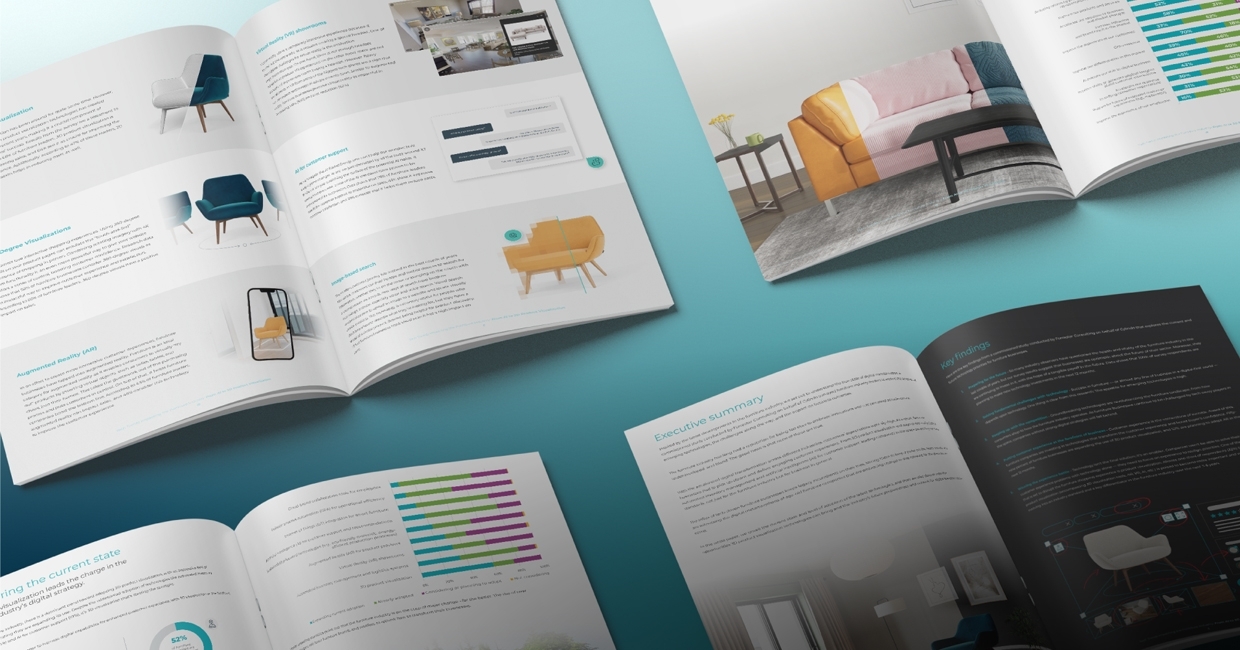In 2024, tough competition and new innovations will see retailers seek resource-efficient ways to enhance the customer experience, with many retailers turning to the latest technologies in order to shake up their traditional workflows, says Jostein Pedersen, VP product - ecommerce for product, production and services at Chaos, who shares four predictions for 3D commerce in furniture retail in 2024 …
One of the technologies being explored is 3D visualisation, including Augmented Reality (AR) and Virtual Reality (VR), with nearly two-thirds (60%) of furniture firms surveyed by Forrester and Chaos expanding their use of such technologies. Seventy percent of firms identified ‘revenue growth’ as a critical priority enabled by 3D visualisation, alongside increased sales and reducing returns.
3D and AR are not just for online
It’s obvious to see the benefits of using 3D product visualisations during the online shopping journey. But for many furniture retailers, the showroom is also a vital element of the experience, which can be further enhanced. Space in any showroom is at a premium, so in the past furniture retailers have had to carefully select only a few models or colour options to be available to view IRL.
Over the past few years - especially during lockdowns - ecommerce has seen massive growth. But moving into 2024, we’ll see those online technologies bring enhanced experiences to blended online/in-store shopping. Some retailers, like Wayfair, have introduced new interactive elements in-store which use 3D product visualisation – for example, screens where customers can visualise their chosen finish or colour of a product, or even place it in a virtual room similar to their home.
Nearly two-thirds (60%) of furniture firms are expanding their use of visualisation technologies, while 93% of furniture leaders rated 3D product visualisation as very to extremely important for their current business strategy.
Rising customer expectations meet rising costs
3D visualisation tools are rapidly becoming industry standard, a status we’ll likely see cemented next year. Retailers are seeking to grow their brands in an increasingly competitive market, characterised by reduced consumer spending and growing expectations for unique retail experiences. In a world of shrinking retail margins, increasing conversions and reducing returns is therefore a top priority.
Personalising product imagery for an entire catalogue across a growing number of shopping channels is a huge challenge. This is especially true in the furniture retail business, where customers need a range of product and lifestyle imagery to make remote purchase decisions with confidence. 3D visualisation can help retailers to meet this customer expectation, without increasing their costs related to photography, studio time, or shipping samples in for photography. For example, outdoor furniture retailer Yardistry successfully doubled its ecommerce sales while reducing photography costs using Cylindo product visualisation.
We found that 56% of furniture organisations employ them to automatically generate or modify images.
AI can help share the burden
Like in many other industries, furniture retailers are excited about the potential of AI technologies to ‘work smarter, not harder’, with many firms already piloting or fully implementing AI in their workflows. AI tools are becoming an integral part of product and lifestyle imagery creation, automating manual tasks which don’t require human creativity, such as image resizing, recolouring, or switching out lifestyle backdrops.
In 2024, we can expect to see furniture firms explore the potential of AI through the whole visualisation process. AI will not only help to speed up repetitive tasks and drive insights based on customer data, but also help brands and retailers to generate content at scale. This will allow ecommerce and marketing professionals to focus more on overall business strategy and creative direction.
We found that 42% of furniture companies use AI for real-time customisation and adaptation of imagery, and 52% of them use AI tools for image recognition, classification and tagging.
Scalability will be key
By embracing the power and scalability of cloud platforms, retailers can turn around massive volumes of assets quickly without the need for lots of additional resources. Once a master asset has been created, it can also be used in a range of marketing channels, such as Google Ad listings, display ads, and email newsletters.
3D visualisation can therefore deliver experience improvements across an omnichannel retail operation. It’s little surprise that a majority of furniture firms think that 3D visualisation will be critical to helping them extend their influence and brand reach over the next 12 months.
In October 2023, we published a commissioned study conducted by Forrester Consulting on behalf of Chaos titled ‘Tech Trends Impacting the Furniture Industry: From AI to 3D Product Visualization’. The study found that nearly two-thirds (60%) of furniture firms are expanding their use of visualisation technologies. A majority (68%) are allocating 10-25% of their budget towards adopting AI and 3D visualisation technologies.
Furniture firms identified some of the top benefits of 3D visualisation technology as: improved customer experience, online or in-store (66%); increased sales, online or in-store (62%); and increased customer engagement, online or in-store (52%).
Companies using our visualisation and rendering technologies to improve marketing workflows, customer experience, and sales include EQ3 and Wayfair.
The results quoted are part of a study issued by Forrester and Chaos commissioned by the latter, whose product portfolio includes the 3D product visualisation platform for commerce, Cylindo.










